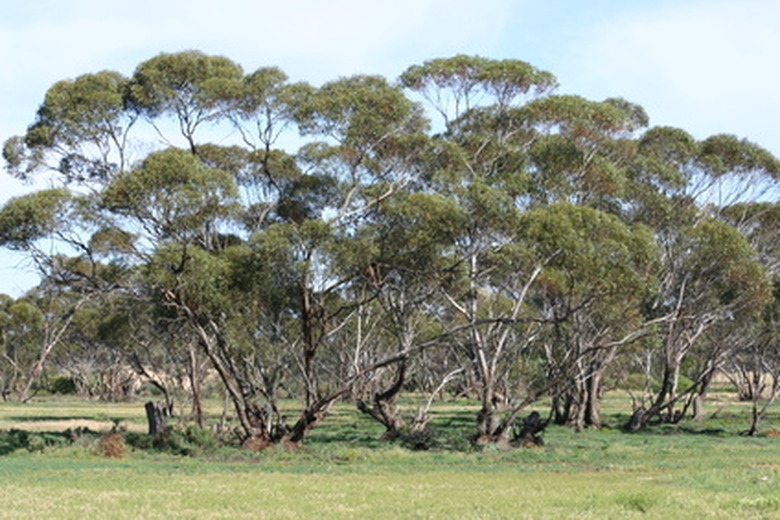Types Of Eucalyptus Trees
There are more than 700 different types of eucalyptus, most of which are native to Australia, with a few species occurring in New Zealand and scattered in the south east Asian Islands just north of Australia. Eucalyptus are often called gum trees because they secrete sap prolifically from wounds on the trunk and branches. Most eucalyptus trees have large, deeply-penetrating root structures to cope with the long dry season in many areas of Australia.
Lemon-Scented Eucalyptus
The lemon-scented eucalyptus (Corymbia citriodora) is native to central and northern Queensland, Australia along the coast. This eucalyptus grows 65 to 100 feet tall with a canopy spread of 30 to 80 feet. It has a tall, slender trunk and the first branch is often halfway up the tree. The leaves are evergreen, but the bark is deciduous, peeling off to reveal smooth white pink or pale blue bark underneath that later turns gray as it ages. The pale green leaves are 5 to 8 inches long and about 1/2 to 3/4 inch wide. When crushed, they give off a lemony scent and contain citronella, which is a natural insect repellent. Lemon-scented eucalyptus require full sun and are susceptible to frost damage. They like a well-draining soil, but are not too picky about the exact soil type. They are drought-tolerant, but require at least 20 inches of rainfall a year to survive.
- There are more than 700 different types of eucalyptus, most of which are native to Australia, with a few species occurring in New Zealand and scattered in the south east Asian Islands just north of Australia.
- Eucalyptus are often called gum trees because they secrete sap prolifically from wounds on the trunk and branches.
Tasmanian Blue Gum
The Tasmanian blue gum (Eucalyptus globulus) is the most widely-grown eucalyptus species in the world. The oil from this tree is frequently used for cough drops and other medicines. The wood from this fast-growing tree is used for carpentry and as fuel. Tasmanian blue gum grows 130 to 230 feet tall, although specimens over 500 feet tall have been reported. The leaves are 4 to 10 inches long and 1 to 2 inches wide. The bark is grey, green or slightly blue. It peels away in long strips revealing light yellow new bark beneath. Tasmanian blue gum requires warm temperatures and may be damaged by frost. It is not particular about soil as long as it drains well.
- The Tasmanian blue gum (Eucalyptus globulus) is the most widely-grown eucalyptus species in the world.
- Tasmanian blue gum requires warm temperatures and may be damaged by frost.
Peppermint Eucalyptus
Peppermint eucalyptus (Eucalyptus dives) is a small-to-medium sized tree that reaches 25 to 80 feet tall with a spread of 25 to 50 feet. It is native to south eastern Australia where it is often planted in rows and used as a windbreak. The leaves are light green, lance-shaped, approximately 3 to 6 inches long and about 1 inch wide. The scented leaves smell similar to peppermint. Peppermint eucalyptus is well adapted to poor, rocky soil, but it can grow in any type of soil that drains well and does not stay wet. It is tolerant of both frost and drought. The tree can tolerate full sun and partial shade.
- Peppermint eucalyptus (Eucalyptus dives) is a small-to-medium sized tree that reaches 25 to 80 feet tall with a spread of 25 to 50 feet.
- Peppermint eucalyptus is well adapted to poor, rocky soil, but it can grow in any type of soil that drains well and does not stay wet.
